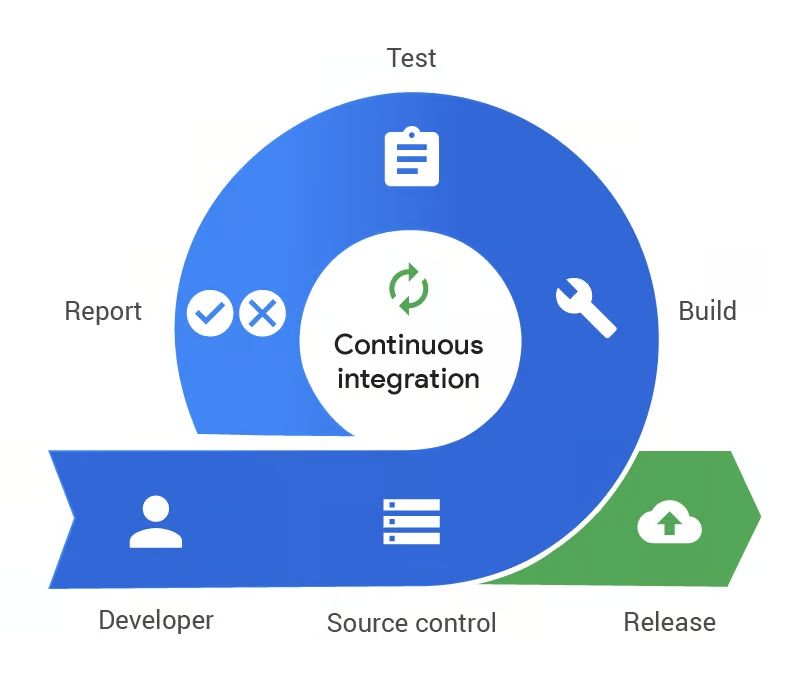
Continuous Integration (CI)
Continuous Integration (CI) is a pivotal practice in DevOps, where code changes are integrated into a shared repository frequently, often multiple times a day. This is crucial for maintaining code quality and speeding up the development process. Unlike traditional practices where integration happened at the end, CI promotes frequent merging of changes, keeping the codebase functional.
CI automates builds and tests, ensuring that each code change is verified immediately. This early detection and resolution of issues reduce debugging time and improve code quality. The immediate feedback helps developers address problems quickly, enhancing overall productivity.
Moreover, CI fosters better team collaboration. With regular integrations, developers stay updated on each other’s work, improving communication and coordination. This approach not only maintains a high-quality codebase but also creates a culture of teamwork and accountability.
The Importance of Continuous Integration
CI automates builds and tests, ensuring that each code change is verified immediately. This early detection and resolution of issues reduce debugging time and improve code quality. Automated testing plays a critical role in CI, as it ensures that new changes do not break existing functionality. By running a suite of tests automatically with each integration, CI helps catch bugs early in the development process, making it easier and faster to fix them.
The immediate feedback provided by CI systems is invaluable. Developers receive instant notifications if their changes cause any issues, allowing them to address problems quickly. This rapid response capability enhances overall productivity by minimizing downtime and preventing the accumulation of errors that can become more difficult to resolve over time.
Enhancing Team Collaboration
Moreover, CI fosters better team collaboration. With regular integrations, developers stay updated on each other’s work, improving communication and coordination. This transparency helps in identifying and resolving conflicts early, which is especially important in larger teams where multiple developers might be working on different parts of the codebase simultaneously.
CI encourages a shared responsibility for the codebase, creating a culture of teamwork and accountability. When everyone integrates their work frequently, the team can quickly identify who introduced a particular change and address any issues collaboratively. This collective ownership leads to more robust and reliable software.

Reducing Risks and Accelerating Development
Continuous Integration also plays a crucial role in reducing risks associated with software development. By integrating code frequently, teams can detect and address integration issues early, rather than facing a large number of conflicts at the end of the development cycle. This approach reduces the risk of project delays and ensures that the software is always in a releasable state.
Furthermore, CI accelerates the development process. With automated builds and tests, teams can move faster without compromising quality. This speed is particularly beneficial in agile development environments, where quick iterations and continuous delivery are essential. CI supports these methodologies by ensuring that the code is always in a deployable state, ready for the next release.

Tools and Best Practices
Several tools facilitate the implementation of Continuous Integration, such as Jenkins, Travis CI, CircleCI, and GitLab CI/CD. These tools offer various features, including automated builds, testing, and deployment, which are integral to a successful CI pipeline. Adopting best practices, such as maintaining a clean and modular codebase, writing comprehensive tests, and using version control effectively, further enhances the benefits of CI.
Implementing CI requires a cultural shift within the development team. It necessitates a commitment to frequent integration, continuous testing, and proactive communication. Teams must be willing to adopt new workflows and tools, and organizations should invest in training and resources to support this transition.
Conclusion
In conclusion, Continuous Integration is a fundamental practice in the DevOps landscape that offers numerous benefits, from improving code quality and team collaboration to accelerating development and reducing risks. By integrating code changes frequently, automating tests, and fostering a culture of collaboration, CI helps teams deliver high-quality software more efficiently. Embracing CI is essential for any organization aiming to enhance its software development process and achieve greater agility and reliability in its products.

Share this article
Follow us
A quick overview of the topics covered in this article.
Latest articles
January 3, 2026
January 3, 2026
January 3, 2026





